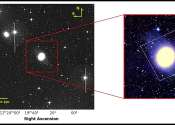Observations explore globular cluster system in the galaxy NGC 4262
Using the Canada-France-Hawaii Telescope (CFHT), Indian astronomers have performed wide and deep field observations of a polar ring galaxy known as NGC 4262. Results of the observational campaign, published April 15 on the ...









